Great Migration Adventure
US$4,336 Per person sharing
One of the most sought-after experiences for wildlife and nature enthusiasts, the Great Migration is the ever-moving circular migration of over a million animals across the Serengeti-Mara ecosystem. The constant movement of columns of wildebeest, joined by a host of companions, follow an age-old route in search of grazing and water. After calving in the southern part of Tanzania's Serengeti near the Ngorongoro Conservation Area, the animals journey through the Serengeti up and around in a clockwise direction towards the Masai Mara in Kenya, before returning once again near the end of the year. Along the way, high drama is always present, as thousands of animals are taken by predators and thousands more are born, replenishing the numbers and sustaining the circle of life.
Below, learn more about what is the Great Migration; find a broad overview of how the migration moves at different times throughout the year; or read some frequently asked questions about the Great Migration.
Alternatively, use the menu tabs below for detailed information on when to travel (including a map of the annual migration), which areas and camps to stay at when on a Great Migration safari, or to view a photo and video gallery of the Great Migration.
The Great Migration is the largest herd movement of animals on the planet. In fact, with up to 1,000 animals per km², the great columns of wildebeest can be seen from space.
The numbers are astonishing: over 1.2 million wildebeest and 300,000 zebra along with topi and other gazelle move in a constant cycle through the Serengeti-Mara ecosystem in search of nutritious grass and water. Guided by survival instinct, each wildebeest will cover 800 to 1,000km on its individual journey along age-old migration routes. Hungry predators including lion, leopard, cheetah, hyena, wild dog and crocs make sure only the strongest survive in this natural spectacle also known as ‘the greatest show on Earth.’
The circuit takes the animals from the Ngorongoro Conservation Area (although not into the Crater itself) in the south of the Serengeti in Tanzania, up through the Serengeti and across into the Masai Mara in Kenya and back again. The journey is beset with danger: young calves are snatched by predators, the slow are brought down by prides of lion, brave beasts break legs on steep river slopes, crocodiles take their share of the stragglers, and the weak and exhausted drown.
The three groups of migrant grazers have different grass-eating habits: as one group eats the top of the tallest grass, the next group will eat away some of the medium-height grass, until finally it is almost completely eaten, and the herds move on. This means each group sticks to their own kind with only a small overlap in their distributions. The grasses of the plains have the highest protein content in the whole of the Serengeti, as well as being high in calcium.
It is unclear how the wildebeest know which way to go, but it is generally believed that their journey is dictated primarily by their response to the weather; they follow the rains and the growth of new grass. While there is no scientific proof of it, some experts believe that the animals react to lightning and thunderstorms in the distance. It has even been suggested that wildebeest can locate rain more than 50km away.
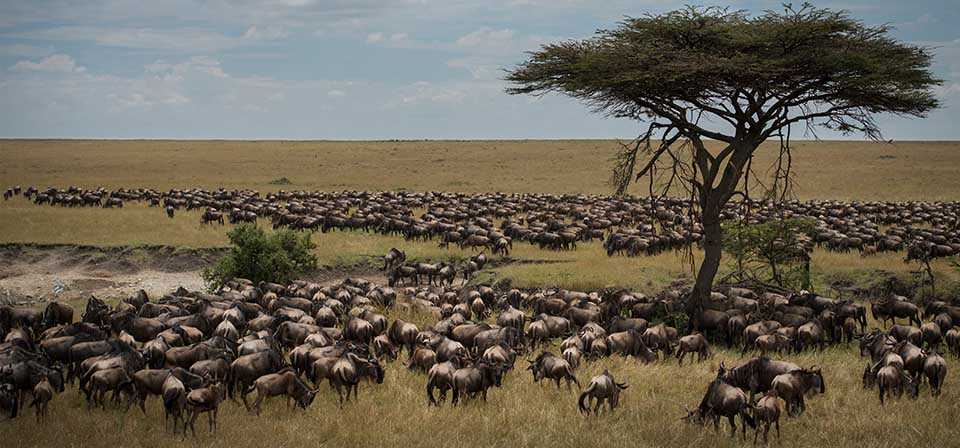
Whether the wildebeest are dropping calves or attempting to cross rivers while avoiding predators, the migration is constantly on the move throughout the year. Read on to learn where the Great Migration tends to be during different times of year, or click on a month below to jump that season of the migration:
January, February and March | April and May | June and July | August, September and October | November and December
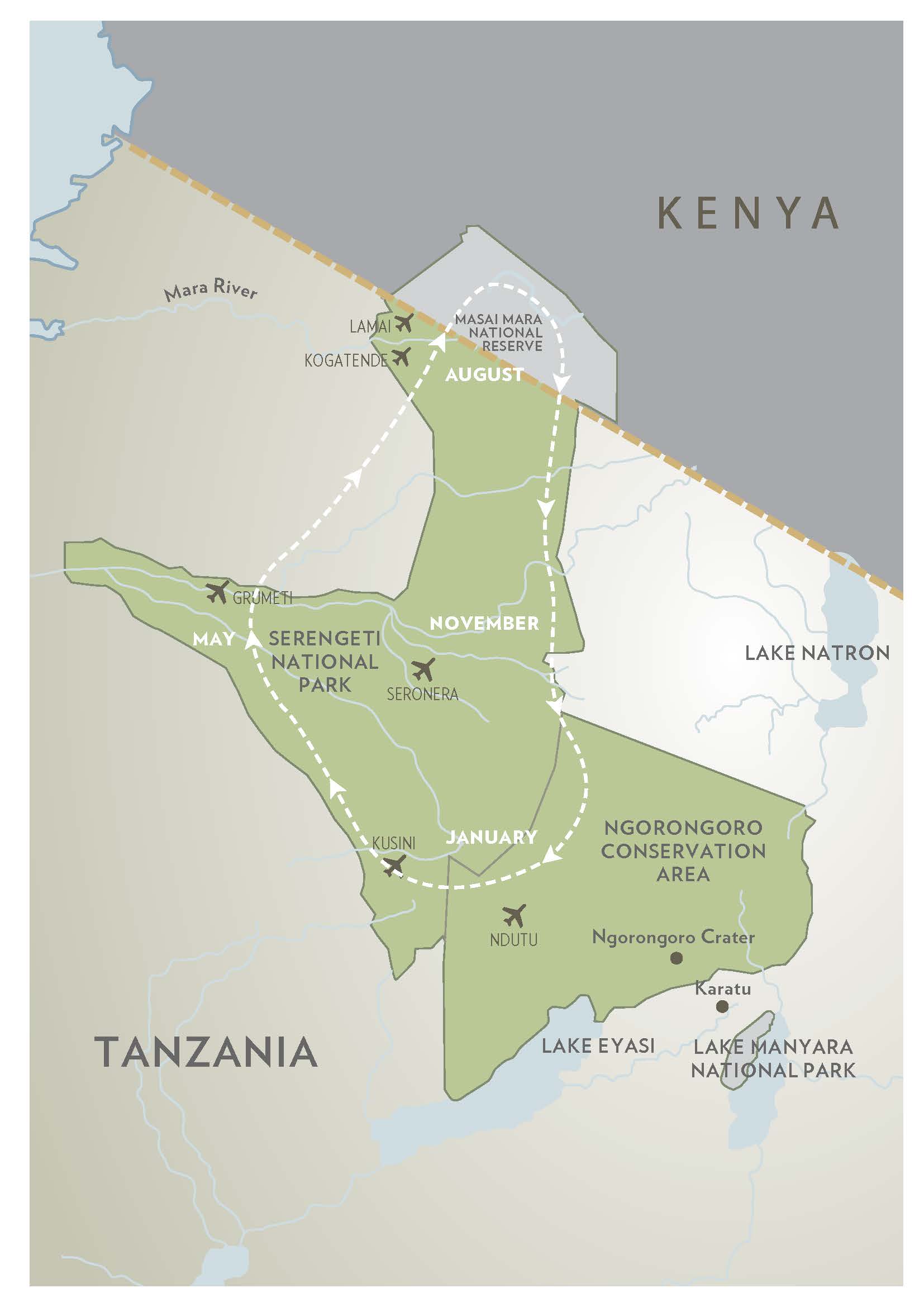
Around January each year, the migration will be finishing a southward trek, moving along the eastern edge of the Serengeti and into the Ngorongoro Conservation Area. Here the plains are rich in nutritious grass, providing the herds with the best conditions for raising their newborn calves.
Although there is no real beginning or end to this migratory circuit — other than birth and death — it seems reasonable to call the wildebeests’ birthing season the start of the migration. Around late January or February, the herds occupy the short-grass plains that spread over the lower northern slopes of the Ngorongoro Crater highlands and around Olduvai Gorge. Some 400,000 calves are born here within a period of two to three weeks, or nearly 8,000 new calves every day.
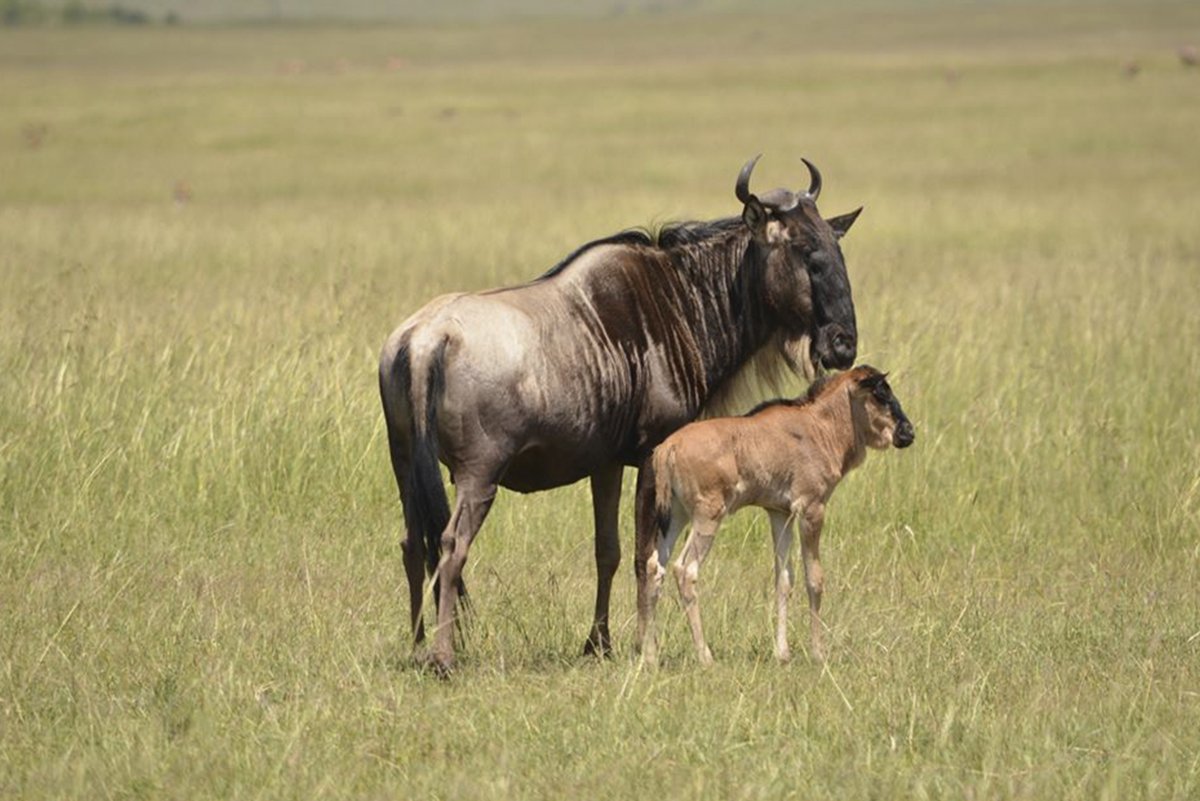
The abundance of vulnerable young calves means the surrounding predators also spring into action, hunting with ease due to the sheer numbers of wildebeest. Those interested in witnessing calving and the drama of big cats on the hunt should look to Asilia's migration camps in the southern Serengeti which provide direct access: Olakira, Kimondo and Ubuntu.
After bearing their young in February and March, around April the wildebeest herds begin to drift northwest toward the fresher grass of the central Serengeti, drawing with them thousands of zebra and smaller groups of antelope. By May, columns of wildebeest stretch for several kilometres as the animals start to congregate by the Moru Kopjes, close to Dunia Camp, one of the few camps in the Serengeti that offers migration viewing at this time of year. Mating season begins toward the end of May and male wildebeest battle head-to-head. Throughout 'the rut,' the journey continues at leisure with the wildebeest, zebra and gazelle grazing as they go along.
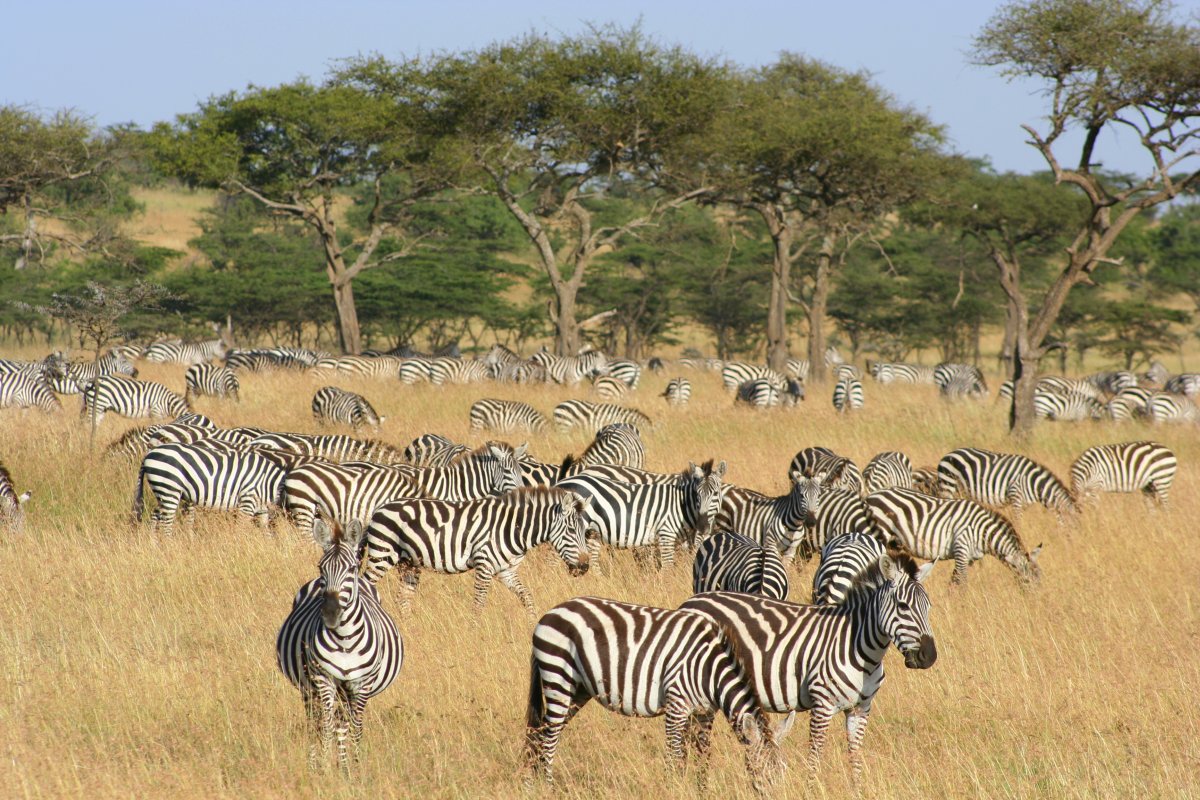
Gradually, the movement gathers momentum and the wildebeest start to mass in the Serengeti’s Western Corridor. At this time of year, Ubuntu Migration Camp will have relocated to follow the migration and provide access to watch the wildebeest cross the Grumeti River. The herds form in huge numbers along the pools and channels of the river, which they have to cross in order to continue on their journey. This may not be as spectacular as the famous Mara crossings, but there are still enough wildebeest to provide the Grumeti crocs with a veritable feast. It is worth noting that May is low season at Ubuntu. Safaris at this time offer great value since there are relatively low numbers of tourists in the Serengeti, yet the wildlife viewings remain excellent.
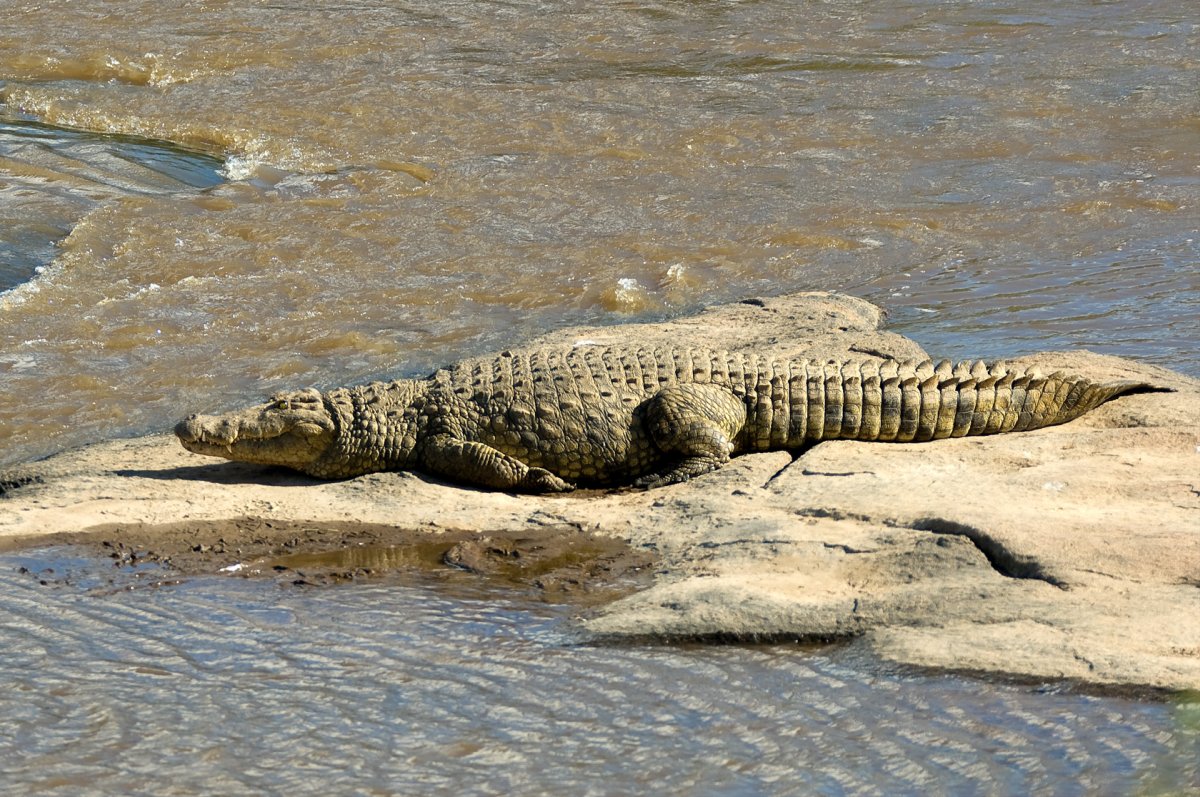
During June, the dry season starts with large concentrations of wildebeest in the Western Serengeti and on the southern banks of the Grumeti River. Each migrating animal must face the challenge of crossing the crocodile-infested river — the first of many daunting and tense river encounters.
As June moves into July, the hundreds of thousands of wildebeest and zebra continue to head north along the western edge of the park toward an even riskier barrier: the Mara River in the north of the Serengeti. These river crossings are arguably one of the most exciting wildlife events on Earth. They usually begin at the onset of high season in July, but timing all depends on nature.
The herds will typically be found in the Northern Serengeti in the month of July, where access is provided by Asilia's mobile migration camps as well as Sayari Camp (for those looking to indulge just a little bit more). Later in July, those animals that have successfully made it across the Mara River will also be found in the Masai Mara, where guests of Rekero Camp can watch river crossings right from the main deck of the camp on their Kenyan safari. At this time, daily river crossings can be seen at the Mara and Talek rivers, both often central to incredible scenes.
By August, the herds have faced the challenge of crossing the Mara River and are spread throughout the Masai Mara's northern region, with many remaining in the northern Serengeti. In years when the river is in full flow, the panic and confusion at the crossings — combined with waiting predators and surging currents — can cause massive loss of life. But, even in years of relatively gently flowing water, the crocs take their toll, not to mention the lions and other large predators that patrol the banks, ready to ambush any wildebeest that make it to the other side. There is no single crossing: at some spots, there are just a few individuals, while others see a mass of animals moving without break for hours.
By September to October, the main chaos has ended and the migrating columns have gradually moved eastward. However, they wildebeest will face the heavy waters of the Mara River once more as they prepare to cross once again for their return journey southward.
After the East African short rains in late October and early November, the wildebeest move down from Kenya and into the eastern limits of the Serengeti past Namiri Plains, an area known for outstanding cheetah sightings. By December, they are spread throughout the eastern and southern reaches.
In the early months of the new year, the grasses in the deep south of the Serengeti are lush with rain. This draws the herds of wildebeest and hundreds of thousands of zebra and other plains animals. The cycle continues as the calving season starts once again.
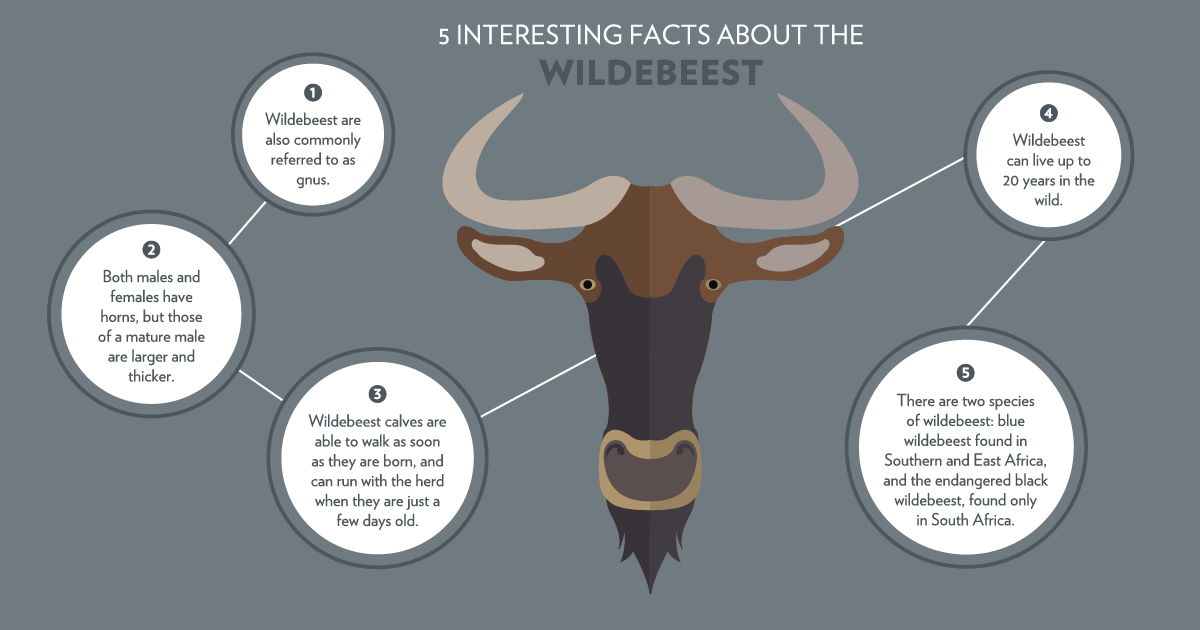
With our camps positioned all along the migration route, our guests have a high chance of seeing the migration at any time of year. Three of these are mobile camps that move around the Serengeti throughout the year to ensure guests are in the best possible position to witness the Great Migration in all its glory. These camps are Ubuntu Migration Camp, Kimondo Migration Camp and Olakira Migration Camp.
Also situated in the Serengeti are our permanent safari camps Namiri Plains, Dunia and Sayari.
When the migration is in Kenya, guests can experience this spectacle at Rekero in the Masai Mara, or at Naboisho or Encounter Mara, both of which are nearby in the Mara-Naboisho Conservancy.
Find out more here about the best safari camps to stay at to see the Great Migration.
 Blog
Blog
Every year, millions of hooves drum against Africa’s plains, raising dust and devouring kilometres as wildebeest, zebra and gazelles trek across the Serengeti and the Masai Mara. Called the Great Migr…
 Blog
Blog
 Blog
Blog
By Akil Halai – Tanzania Field Ops Coordinator The massive moment we are all anxious for that happens once or twice every year is when we begin moving our mobile camps. Asilia has three truly mobile c…
 Blog
Blog
When most people think of the ‘Great Migration’, they think of the iconic wildebeest river crossings. The Great Migration is in fact a year-long cyclical event, with plenty of action to be found all y…
 Blog
Blog
 Blog
Blog
The post Namiri Plains and the Great Migration appeared first on Asilia Africa.
 Blog
Blog
By Britta Foulis The Great Wildebeest Migration is an annual event which covers a circular route of over 1 000 km. This journey stretches all the way from the northernmost reaches of the Masai Mara in…
The Great Wildebeest Migration is the largest animal migration in the world. Every year, more than 2 million animals (wildebeest, zebra, and gazelle) migrate in a clockwise direction across the ecosystems of the Serengeti (Tanzania) and the Masai Mara (Kenya). On the way, they have to cross crocodile-infested rivers, are hunted by predators, and face natural disasters such as droughts and flooding in a daily struggle for survival.
Asilia Africa operates a number of camps specifically along the route of the migration to offer you a front-row seat to all the migration action. For example, Sayari Camp is located close to many of the Mara River crossing points in the Northern Serengeti. We have three mobile camps in the Serengeti which move to two or three locations in a year to ensure proximity to the action of the migration, while other camps are in a fixed location and offer additional amenities such as swimming pools.
The Great Migration can be enjoyed year round. The first few months of the year offer exceptional predator encounters in Tanzania's Serengeti as this is the calving season for the wildebeest and newborns make for easier targets. By July, the herds are heading north into the central Serengeti where the wildebeest make their first river crossing, and take their chances against the waiting crocodiles. In August, the herds cross over into Kenya’s Masai Mara and towards the end of the year the herds move southwards back into the Serengeti where the animals brace themselves for the next calving season and predator attacks.
You can read more here about what to expect from the migration each month as well as which of our camps are best positioned to enjoy this spectacle at those times of year.
Throughout every year in East Africa, wildebeest along with zebra, gazelle and other animals, migrate in spectacular herds comprising millions of animals altogether across Kenya and Tanzania. This is known as the Great Migration. Read more here for the best safari camps to stay at during a Great Migration vacation.